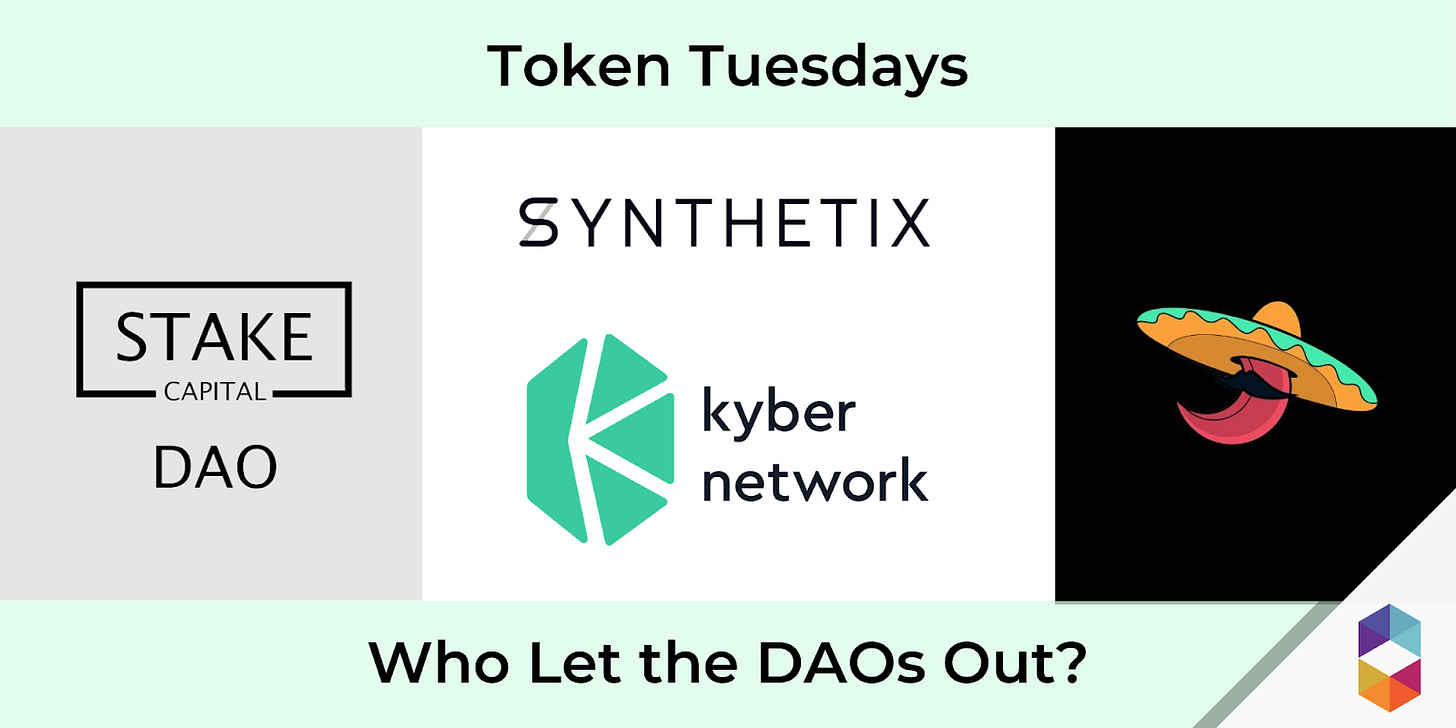Who Let the DAOs Out?
A few weeks back, we talked about the Rise of Distributed Autonomous Organizations, better known as DAOs. For those unfamiliar, you can think of a DAO as a way to coordinate around a common goal using smart contracts as a treasury account. While the structure of certain DAOs may vary, they all allow for decision making to be distributed among a community, rather than by a hierarchical company.
Since then, we’ve seen a number of projects express plans to transition to a DAO model. We wanted to take this time to break down some of the similarities and differences among them, along with offering our insights as to where this trend is bringing the ecosystem as a whole in the coming year.

Recent DAO Transitions
Kyber Network
Kyber Network - an Ethereum leading DEX and on-chain liquidity protocol - recently announced the integration of KyberDAO into the heart of their ecosystem. While Kyber has toyed around with DAO ideas in the past, the recent Katalyst upgrade solidified that a DAO will act as a core part of the ecosystem moving into 2020.
Katalyst brings a new token which will not only allow KNC holders to earn network fees by staking KNC, but also participate in governance through the KyberDAO. The KyberDAO will give token holders the ability to decide on how the fees for the network (currently 0.25%) will be distributed between staking rewards, maker/reserve incentives, and the amount of KNC burned

“Holders who stake and participate in the KyberDAO get their share of the fees designated for rewards. The more KNC staked, the bigger the share of fees.”
In the future, Kyber anticipates that the DAO will also have power to approve listing and delisting of token pairs, reserve approvals, as well as network development grants. Ultimately, Kyber hopes to integrate token holders as a critical aspect over determining protocol incentives and the surrounding parameters.
Synthetix
Synthetix, the industry’s largest synthetic asset issuance protocol, announced its plan to transition to a DAO earlier this week in order to create an inclusive mechanism for token holders to govern the protocol and its underlying treasury. If you’re unfamiliar with Synthetix, you can brush up on the project here.
The recent announcement shows Synthetix’s commitment to fulfilling the core ethos of DeFi and truly becoming a decentralized, open, and permissionless protocol. With this in mind, the announcement outlines a few key components necessary to make this transition successful and provide the DeFi ecosystem with a fully decentralized and unstoppable protocol for synthetic assets.
Legal & Operational - In the past, it has been common practice to set up a non-profit foundation to coordinate protocol development within decentralized systems. This was due to the lack of robust frameworks for distributed fund management. Thanks to the rise of new DAO structures such as Moloch, Synthetix can now leverage an audited foundation for distributed treasury management, grants, and governance.
Protocol Changes - As it stands today, the Synthetix team is largely responsible for implementing protocol changes while receiving input from the community via Synthetix Improvement Proposals (SIPs). With that, the team is working on developing a protocol DAO to allow community members to be more involved with the SIP process.
While it would seem that protocol changes and product improvements are interchangeable, there’s actually a clear distinction between the two. To give you a better understanding, Synthetix.Exchange and Mintr are some of the products that exist on the Synthetix Protocol.
Drawing a parallel, Uniswap’s front-end exchange (the product) geoblocked a handful of countries while the core protocol itself remains censorship-resistant and accessible by anyone. As such, the goal with Synthetix DAO is to decentralize and eliminate any single point of failure from the products that exist on top of the protocol. This can be accomplished through grants from the DAO and by ensuring that multiple products emerge outside of what’s been developed by the core team.
Parity Technologies
Parity Technologies, one of the core Ethereum-focused development shops announced their transition towards a DAO ownership and maintainer model over the Parity Ethereum codebase. While it wasn’t explicitly stated in the announcement post, this transition largely has to do with Parity’s dedication towards the Ethereum competitor, Polkadot. With that in mind, it made little sense for Parity to continue allocating its resources towards maintaining the Ethereum codebase.

With this transition, Parity plans to transfer the development license to the DAO and move the codebase to its own GitHub organization. Memberships and voting power in the DAO will leverage a stake-weighted token system. By leveraging a DAO-based infrastructure, it creates a fair and transparent mechanism for continuing to develop on the Parity’s Ethereum codebase.
The initial distribution of OpenEthereumDAO token have yet to be announced with the expectation for more details surrounding the transition set to take place in the coming weeks.
For-Profit DAOs
While DAOs provide a robust framework for governance over decentralized protocols, one of the more interesting developments with the recent rebirth is the potential with for-profit DAOs. Given that The DAO back in 2016 essentially aimed to act as a distributed venture capital fund, it comes as no surprise that we’re beginning to see the re-emergence of this model. For-profit DAOs provide members with the potential for tokenized investment claims in exchange for coordinating and maintaining the DAO.
Stake DAO
Our Year of Staking post outlined the proliferation of staking mechanisms and how this trend will likely continue in the coming years. New financial primitives within DeFi are emerging to enable staking, borrowing, lending, derivatives, and insurance amongst other use-cases.
Stake DAO is a revenue-sharing project enabling token holders to continuously earn staking rewards from profits generated by the parent company Stake Capital. In essence, Stake DAO will distribute rewards from a basket of staking services to delegators and actors via the Stake Capital Token (SCT).
Stake Capital Tokens have a fixed supply and will be distributed at a continuously diminishing rate. This rewards model aims to incentivize early delegators. In addition, SCT token holders are given governance rights over the DAO, which include determining new DeFi services, changing the token distribution rate among other things.
Stake DAO recently announced they will be leveraging Aragon for their foundation, largely due to the network of tools available for unique userswithin the DAO. A solid primer of what these tools enable can be found here.
MetaCartel Ventures
You may recall us mentioning MetaCartel - the first fork of Moloch focused on funding the Ethereum application layer - in our last DAO post. Since then, MetaCartel recently announced a new arm called MetaCartel Ventures (MCV) - a for-profit DAO seeking to make larger investments in projects in exchange for future returns.
What makes MCV different from the grant-giving DAO is the inherent expectations for profits. Upon collecting more than $5M in funding, MCV will be able to allow non-accredited investors to participate and hold shares in the DAO so long as they are actively participating in the venture's daily operations. This structure is incredibly novel as it marks the first known use case of a distributed organization compliantly pooling funding and knowledge from a collective of both accredited and non-accredited investors.
Seeing as MetaCartel currently contains some of the most connected individuals in the space, it’s likely that MCV will be able to lead investments in some Ethereum’s most promising applications, making it an incredibly attractive notion for passive investors curious as to how they can put their blockchain-focused capital to good use.
While MetaCartel Ventures is not currently live, you can read up on its structure and plan of attack via the official whitepaper.
A Distributed Future
Tying all of these ideas together, let’s take a look at what each of these new models have in common.
For one, the transition or use of a DAO further incentivizes community participation by providing tangible rewards for actions such as voting or staking. In the past, we’ve seen utility models that largely tried to encourage this behavior, but lacked the tooling or frameworks in order to make this a reality.
With this new wave of DAOs, we expect governance to be more intuitive than ever before. This will likely take the form of user-friendly dashboards paired with more established frameworks for things like proposals and on-chain voting.
Across the board, we can all agree that governance participation has been one of the categories that many projects have failed to motivate across their circulating supply at large. We would hope that by sharing upside to those who actively participate, more non-technical users will take the time to read up on changes and voice their opinions.
These frameworks also pose new use-cases for how many of these tokens are actually used. Whereas previous token models largely thrived on speculation, we’re continuing to see innovative new ways for token supplies to be directly correlated to the growth and usage of an underlying product.
If one thing is for sure, this new explosion in DAO interest has certainly helped steer us back on track and we personally couldn’t be more excited to watch and participate in many of the projects mentioned above.
If you or your business are interested in learning more about DAOs and how to leverage them to your benefit, give us a shout!
Until then, be sure to stay up to date on all things blockchain via the official Fitzner Blockchain Twitter.
Happy Holidays from Cooper, Lucas and the rest of the Fitzner Team!


